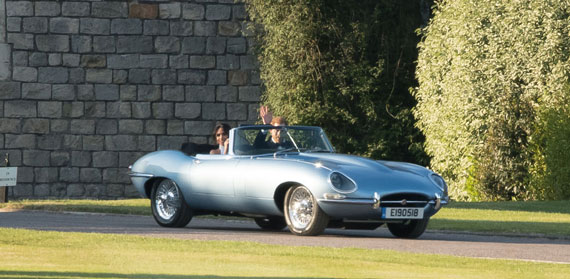Getty Images licensed.
Guest post by Cristiana Pace, Centre for Business in Society
On Saturday 19th of May, Prince Harry and Megan Markle departed Windsor Castle for the reception hosted by Prince of Wales, in a silver blue Jaguar E-Type Concept Zero, under the eye of millions of spectators. This car, originally manufactured in 1968, was then converted to electric power. Pictures of the Duke and Duchess of Sussex in this car, which Enzo Ferrari defined as “The most beautiful car ever”, has been published in magazines and newspapers globally, attracting the interest of millions of people and showcasing how the electric powertrain can be harmonised with such an iconic car.
Although electric vehicles have been around since 1980, the uptake has been very slow in the last 40 years if compared with the rate of adoption of diesel engine vehicles in the same span of time.
Whilst the engineering community has initially blamed technology, as FEV cars were not able to offer the same value proposition of Internal Combustion Engine (ICE) powered cars, in terms of cost, aesthetic and range, social scientists have flagged out as the change from ICE to FEV is not only about technology, but also includes social factors such as consumer choice, preference and society belief.
If the obstacle to the wider adoption of FEV is socio-technical rather than technical, then what is needed to embrace the change?
The answer is indeed showcasing vehicles – something that both motorsport, through ABB FIA Formula E, and the choice of car of the Duke and Duchess of Sussex are doing.
In 2014, the FIA introduced the first all-electric powered racing car championship. ABB FIA Formula E has since grown and globalised attracting well known partners such as ABB, Michelin, DHL, VISA and Julius Baer.
Additionally what was once a championship dominated by entrepreneurs and handful of manufacturers in 2014, now in season six will count nine different manufacturers.
Amongst these manufacturers OEMs such as BMW, Mercedes, Porsche, Renault and Jaguar have joined the electric race alongside well established FEV companies such as NIO, Venturi and Mahindra. This new championship showcases the electric powertrain in ten different city centres around the globe, bringing the powerful message that electric cars are fast, fun and sexy.
Public support is crucial for decarbonised transportation and it is only by showcasing FEV technologies in a global setting that society will embrace this and any new technologies, facilitating the shift.
As such, social science is indeed relevant and in need of consideration when talking about FEV or autonomous vehicles, as Professor Lyndon Simkin has knowledgeably pointed out in his latest blog ‘Inspiring investment or wishful thinking’.




Comments are disabled